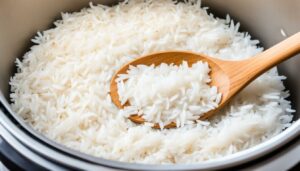Welcome to our exploration of broken rice vs normal rice! Rice is a staple food for millions of people around the world, and there are many varieties available. One of the main differences between types of rice is the level of processing they undergo. Broken rice and normal rice are two such varieties, both of which are commonly used in many cuisines. In this article, we’ll delve into the key differences between these two types of rice and help you determine which may be best for your needs.
Table of Contents
Key Takeaways:
- Broken rice and normal rice are two common varieties used in many cuisines.
- One of the main differences is the level of processing they undergo.
- Broken rice is produced during the milling process when grains break into small fragments.
- Normal rice varieties include white rice, brown rice, basmati rice, and more.
- Broken rice has a different texture and taste than normal rice and may offer unique nutritional benefits.
- Both types of rice can be cooked and used in a variety of dishes.
- The price and availability may vary depending on market demand and supply.
- When determining which is better for specific purposes, consider factors such as taste, texture, nutritional value, and cooking methods.
Understanding Broken Rice
Broken rice is a type of rice that is produced during the milling process when the rice grains break into smaller pieces. Broken rice grains are shorter and rounder than their intact counterparts. They are also less visually appealing and typically sold at a lower price.
During the milling process, the outer hulls of the rice grains are removed, and the remaining grains are polished to remove the bran layers. Broken rice is created when these polished grains break during handling and transportation. The level of breakage can vary depending on factors such as the variety of rice, the milling process used, and the quality of the equipment.
How Broken Rice is Produced
Broken rice is produced during the milling process when the rice grains break into smaller pieces. This can occur due to a variety of factors such as the variety of rice being milled, the quality of the milling equipment, or mishandling during transportation or storage.
| Factors that can cause broken rice | Description |
|---|---|
| Variety of Rice | Some varieties of rice are more prone to breakage than others. For example, long-grain rice is more likely to remain intact during milling than short-grain rice. |
| Milling Equipment | The quality of the milling equipment can have a significant impact on the level of breakage. Poor quality equipment can cause more grains to break during the milling process. |
| Transportation and Storage | If the rice is mishandled during transportation or storage, the grains can break due to friction or impact. |
Understanding Normal Rice
Normal rice, sometimes called whole grain rice, is the unbroken form of rice that has not been altered during the milling process. It is available in a wide variety of strains, each with their unique texture, aroma, and flavor, making it a staple in many cultures around the world. In general, normal rice is considered one of the most popular and widely consumed grains globally.
Normal rice is a good source of carbohydrates, providing sustained energy throughout the day. In addition, it contains a variety of essential vitamins and minerals, such as vitamin B and iron, and is low in fat. Regular consumption of normal rice can boost health and provide necessary nutrients for the body.
Popular Varieties of Normal Rice
There are many popular strains of normal rice, each best suited for different cuisines. Basmati and Jasmine rice, for example, are two highly aromatic strains typically used in Indian and Thai cuisines, respectively. Short-grain rice, such as sushi rice and arborio rice, is known for its sticky texture and is commonly used in dishes like sushi and risotto. Medium-grain rice, like Calrose and Bomba, is more versatile and can be used in several dishes, from rice salads to rice pudding.
When it comes to cooking normal rice, it is essential to match the rice strain to the desired dish, as each one has a unique texture and flavor. Properly cooking normal rice requires attention to the rice-to-water ratio and cooking method to ensure the rice is cooked consistently throughout.
Taste and Texture
When it comes to taste and texture, broken rice differs significantly from normal rice. Due to its broken and smaller grain size, broken rice tends to be softer and more tender than normal rice. It also has a slightly chewy texture that makes it ideal for certain types of dishes.
Normal rice, on the other hand, has a firmer and more distinct texture. Depending on the variety, it can range from fluffy and light to sticky and heavy.
However, the taste differences between broken rice and normal rice are minimal. Both have a subtle, nutty flavor that pairs well with a wide variety of ingredients and spices.
Nutritional Differences
When it comes to nutritional value, broken rice and normal rice have some key differences. While both are a good source of carbohydrates, broken rice has a higher glycemic index than normal rice, which means it can cause a quicker spike in blood sugar levels after consumption.
On the other hand, broken rice contains higher levels of certain nutrients, such as thiamin and niacin, which are important for energy metabolism and brain function. It is also rich in fiber and iron, which can help regulate digestion and boost immunity.
Overall, while normal rice may be a better option for those looking for a slower release of carbohydrates, broken rice offers unique nutritional benefits that can be incorporated into a balanced diet.
Cooking with Broken Rice
Broken rice is an excellent option for creating a variety of dishes. Due to its smaller size and unique texture, it is ideal for certain dishes that require a firmer texture and can absorb a lot of flavor. Here are a few tips for cooking with broken rice:
- Rice Dishes: Broken rice is commonly used in a variety of rice dishes like biryani, jambalaya, and fried rice. Due to its porous texture, it absorbs flavors better, making it a perfect ingredient for these types of dishes.
- Porridge: Broken rice can also be used to make porridge, which is a popular breakfast dish in many parts of the world. To make it, just cook the broken rice in milk or water until it becomes soft and creamy. Add any sweeteners or toppings you like, such as honey, nuts, or fruit.
- Rice Noodles: Broken rice can be ground into rice flour, which is commonly used to make rice noodles. Rice noodles are a staple in many Asian cuisines, and are often used in dishes like pho, pad thai, and laksa.
Cooking Tips
When cooking with broken rice, it’s important to keep in mind that it has a shorter cooking time than regular rice due to its smaller size. Here are some additional tips to keep in mind:
| Cooking Method | Cooking Time |
|---|---|
| Stovetop | 15-20 minutes |
| Rice Cooker | 10-15 minutes |
| Instant Pot | 5-7 minutes |
It’s also important to rinse broken rice thoroughly before cooking to remove any excess starch or debris. This will ensure that the rice cooks evenly and doesn’t clump together.
Cooking with Normal Rice
Normal rice, also known as polished rice, is the most commonly consumed type of rice worldwide. It has a neutral flavor and delicate texture, making it a versatile ingredient in various types of cuisines.
Cooking normal rice is a straightforward process; measure the desired amount, rinse thoroughly, add water in a 2:1 ratio for most varieties, and bring to a boil. Reduce the heat to low and let it simmer covered for 18-20 minutes, or until tender.
Here are some popular methods for cooking normal rice:
- Boiling: The most common method of cooking rice, boiling involves adding rice in a pot with water and simmering for the required time until the water is absorbed.
- Steaming: This method involves placing the rice in a steamer basket or colander over boiling water and letting it steam until cooked.
- Microwaving: A convenient method for those in a hurry, microwaving rice involves adding rice and water to a microwave-safe dish and cooking for 10-15 minutes, or until tender.
Normal rice is a staple ingredient in dishes such as stir-fries, sushi, and rice puddings. Its versatility and mild flavor make it an ideal option for those who desire a simple yet delicious meal.
Price and Availability
When it comes to price and availability, there are several factors to consider when choosing between broken rice and normal rice. Broken rice is often less expensive than normal rice, as it is considered a byproduct of the milling process. This means that it may be more widely available in areas where rice is a staple food, but it may be more difficult to find in other regions.
Normal rice, on the other hand, is typically more expensive than broken rice and is available in a wider range of varieties. This is because normal rice is often marketed as a high-quality product, and different types of normal rice may have unique flavors or textures that appeal to different tastes.
Ultimately, the price and availability of broken rice and normal rice may depend on several factors, including the region where it is produced and the demand for rice within that region. It is important to consider these factors when deciding which type of rice is best suited for a particular recipe or meal.
Which is Better: Broken Rice or Normal Rice?
When it comes to deciding which is better between broken rice and normal rice, there are several factors to consider. The choice will depend on personal preferences, cost, availability, and intended use.
Nutritional Value
Normal rice is a better source of nutrients than broken rice. This is because during the milling process, the bran and germ are removed from the rice kernel. These parts contain many vitamins, minerals, and fiber that are essential for good health. Broken rice, on the other hand, contains broken pieces of the rice grain, which are less nutritious than whole grains. However, broken rice has fewer calories than normal rice.
Taste and Texture
Normal rice has a distinct flavor and texture that many people prefer. It is soft, fluffy, and has a slightly sweet taste. Broken rice has a milder flavor and tends to be softer and stickier than normal rice. The texture of broken rice can be a bit more chewy, making it ideal for certain dishes such as sushi.
Cooking and Uses
Normal rice is versatile and can be used in a wide range of dishes, including soups, stews, salads, and stir-fries. It is also easy to cook and requires little preparation. Broken rice is commonly used in dishes such as congee, rice pudding, and risotto. It can also be used in recipes that call for rice flour.
Price and Availability
Broken rice is generally cheaper than normal rice, as it is seen as lower quality. It is widely available in Asian markets and specialty stores, but may be harder to find in mainstream grocery stores. Normal rice is more widely available and can be found in most grocery stores and supermarkets. The price of normal rice may vary depending on the variety, with certain types being more expensive than others.
Ultimately, when it comes to choosing between broken rice and normal rice, it is important to consider personal preferences, cost, and intended use. Both types of rice have their unique qualities and can be used in a variety of dishes.
Conclusion
After exploring the key differences between broken rice and normal rice, it is clear that both varieties have their unique qualities and benefits. Broken rice is a versatile ingredient that can be used in a variety of dishes and offers unique nutritional advantages, while normal rice is a staple grain with a long history of culinary uses.
When it comes to deciding which is better, it ultimately depends on your individual needs and preferences. If you are looking for a budget-friendly option with a longer shelf life, normal rice may be the way to go. However, if you are interested in a more nutrient-dense option that can add texture and flavor to your meals, broken rice is worth considering.
Choosing the Right Rice for Your Cooking Needs
Ultimately, the choice between broken rice and normal rice comes down to personal preference and intended use. Consider the flavor profile, texture, and nutritional value of each type when selecting the right rice for your cooking needs.
Whether you choose broken rice or normal rice, both varieties can add depth and richness to your meals and provide a satisfying staple to your pantry. Experiment with both and enjoy the diverse tastes and textures that rice can offer.
FAQ
Q: What are the differences between broken rice and normal rice?
A: Broken rice and normal rice have distinct differences in terms of appearance, texture, taste, and nutritional value.
Q: How is broken rice produced?
A: Broken rice is produced during the milling process when the rice grains break or shatter into smaller pieces.
Q: What is normal rice and what is its nutritional value?
A: Normal rice refers to intact rice grains with various popular varieties such as jasmine, basmati, or white rice. It provides essential carbohydrates and some vitamins and minerals.
Q: How do broken rice and normal rice differ in taste and texture?
A: Broken rice tends to have a slightly different texture and may cook quicker than normal rice. As for taste, broken rice can offer a distinct flavor depending on the variety.
Q: Are there any nutritional differences between broken rice and normal rice?
A: While broken rice and normal rice share similar nutritional profiles, broken rice may contain higher levels of certain nutrients due to the increased surface area.
Q: What are some ways to cook with broken rice?
A: Broken rice is versatile and can be used in a variety of dishes like porridge, rice pudding, or even fried rice.
Q: Are there any specific cooking tips for normal rice?
A: When cooking normal rice, it’s important to follow the recommended water-to-rice ratio and cooking time for the specific variety being used.
Q: How do the price and availability of broken rice compare to normal rice?
A: Broken rice is often more affordable compared to normal rice and can be found in many rice markets or specialty stores, depending on regional availability.
Q: Which is better, broken rice or normal rice?
A: The choice between broken rice and normal rice depends on personal preferences, specific culinary needs, and the desired texture in the final dish.
Q: What are the key differences between broken rice and normal rice?
A: Broken rice and normal rice differ in terms of appearance, texture, taste, nutritional value, cooking methods, availability, and price.






